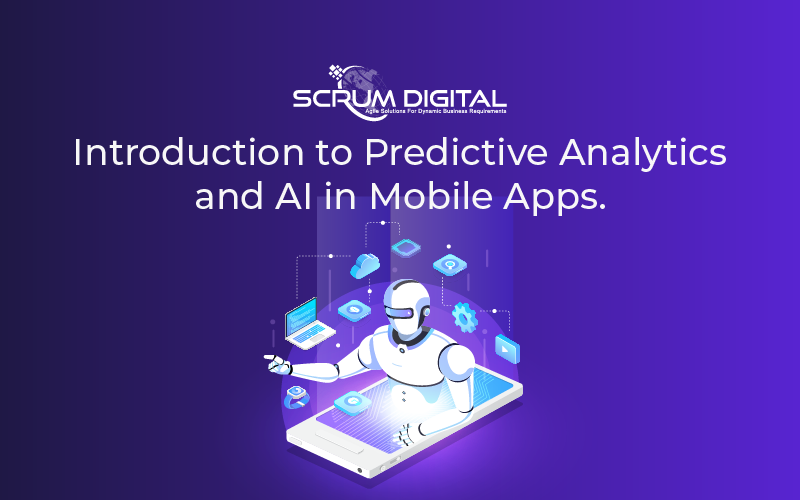In today’s fiercely competitive mobile app landscape, staying one step ahead of user preferences and behaviors is the key to success.
Predictive analytics and artificial intelligence (AI) have emerged as indispensable tools for app developers and businesses looking to enhance user experiences, drive engagement, and boost conversions.
Predictive analytics leverages historical data to forecast future user actions, while AI empowers mobile apps to adapt and anticipate user behavior in real-time.
In this blog, we’ll delve into the dynamic world of predictive analytics and AI, exploring how these cutting-edge technologies are revolutionizing mobile app development.
Discover how predictive analytics and AI can help your mobile app not only meet but exceed user expectations, ensuring a competitive edge in the ever-evolving app market.
Understanding User Behavior: Why is it Important to Anticipate User Behavior?
Understanding user behavior is the cornerstone of successful mobile app development and digital strategies. Anticipating user behavior allows businesses to tailor their offerings, content, and experiences to meet users’ needs before they even realize them.
This proactive approach not only enhances user satisfaction but also leads to increased engagement, longer user retention, and ultimately, higher conversions. By leveraging predictive analytics and AI-driven insights, businesses gain a competitive edge in today’s fast-paced digital landscape.
In this blog, we’ll delve into why anticipating user behavior is crucial for your mobile app’s success and how predictive analytics and AI can empower you to stay ahead of the curve.
Using Predictive Analytics in Mobile Apps: How Can Predictive Analytics Help Anticipate User Behavior?

Predictive analytics is the secret sauce behind successful mobile apps, offering a powerful toolset for understanding and predicting user behavior. By analyzing vast datasets of user interactions, preferences, and historical patterns, predictive analytics can unveil valuable insights.
These insights enable mobile app developers to anticipate user needs, tailor content, and even suggest actions, providing users with a more personalized and engaging experience.
Whether it’s predicting which products a user might be interested in, forecasting churn to retain customers, or optimizing content delivery, predictive analytics empowers mobile apps to stay one step ahead. In this blog, we’ll explore the myriad ways in which predictive analytics can be harnessed to enhance user experiences and drive app success.
Implementing AI in mobile apps: How can AI enhance the user experience and predict User behavior?
Implementing artificial intelligence (AI) in mobile apps opens up a world of possibilities for improving user experiences and anticipating user behavior. Here are five powerful ways in which AI can work its magic:
1. Personalization:
AI algorithms analyze user data to provide personalized recommendations, content, and features, creating a tailored experience that resonates with each individual.
2. Predictive Analytics:
AI excels at forecasting user behavior based on historical data, helping businesses make informed decisions and proactively address user needs.
3. Chatbots and Virtual Assistants:
AI-driven chatbots offer real-time support, enhancing user engagement and satisfaction by providing instant answers and assistance.
4. User Behavior Insights:
AI can uncover hidden patterns and insights within user behavior, helping apps fine-tune their strategies and content to better align with user preferences.
5. Automated Content Generation:
AI can generate dynamic, context-aware content, such as personalized news feeds or product recommendations, enhancing user engagement and retention.
By harnessing these AI-powered capabilities, mobile apps can not only deliver exceptional user experiences but also stay ahead by anticipating and meeting user expectations in today’s competitive digital landscape.
Read More: How to Choose the Right AI App Development Company for Your Business?
Best Practices for Incorporating Predictive Analytics and AI in Mobile Apps.
Incorporating predictive analytics and artificial intelligence (AI) into mobile apps can significantly boost their performance and user engagement. To ensure successful integration, it’s essential to follow some best practices.
Firstly, start with a clear understanding of your app’s goals and user base, as this will inform the data collection and model development processes.
Secondly, prioritize data quality and privacy by implementing robust data governance and protection measures.
Thirdly, regularly update and fine-tune your predictive models to adapt to evolving user behaviors and preferences.
Additionally, focus on seamless user experiences by carefully implementing AI features to enhance, not disrupt, the app’s usability.
Lastly, stay updated with industry trends and advancements to remain competitive in the ever-evolving landscape of mobile app development.
By following these best practices, you can harness the full potential of predictive analytics and AI to create mobile apps that delight users and drive business success.
How Can Scrum Digital, as a Team, Help You Make Better Mobile Apps with AI?
Scrum Digital, as a highly skilled and experienced team, can be a game-changer in the development of mobile apps integrated with Artificial Intelligence (AI). Their proficiency in Scrum methodology ensures efficient collaboration, adaptability, and precision throughout the development process.
Scrum Digital promotes regular communication among team members, ensuring that AI functionalities align seamlessly with user expectations and needs.
Through iterative cycles, the team continually refines AI algorithms, enhancing their predictive capabilities and improving user experiences.
Moreover, Scrum Digital’s structured sprint approach enables teams to quickly address evolving AI requirements, keeping mobile apps on the cutting edge of technology.
By partnering with Scrum Digital, you can harness the full potential of AI, delivering mobile apps that are not only smarter but also perfectly tailored to meet user demands in today’s competitive digital landscape.



